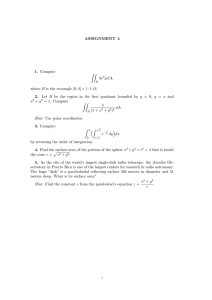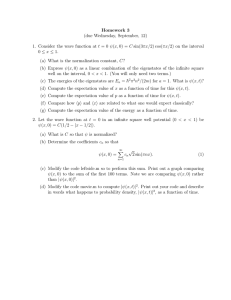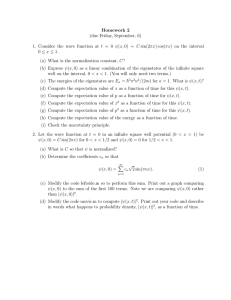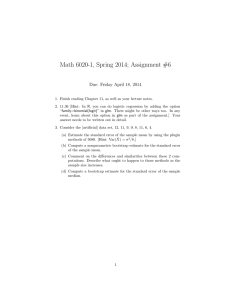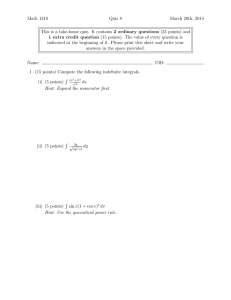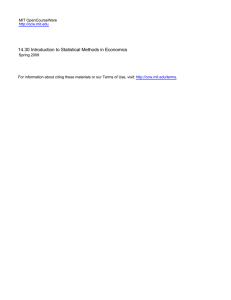14.30 Introduction to Statistical Methods in Economics
advertisement
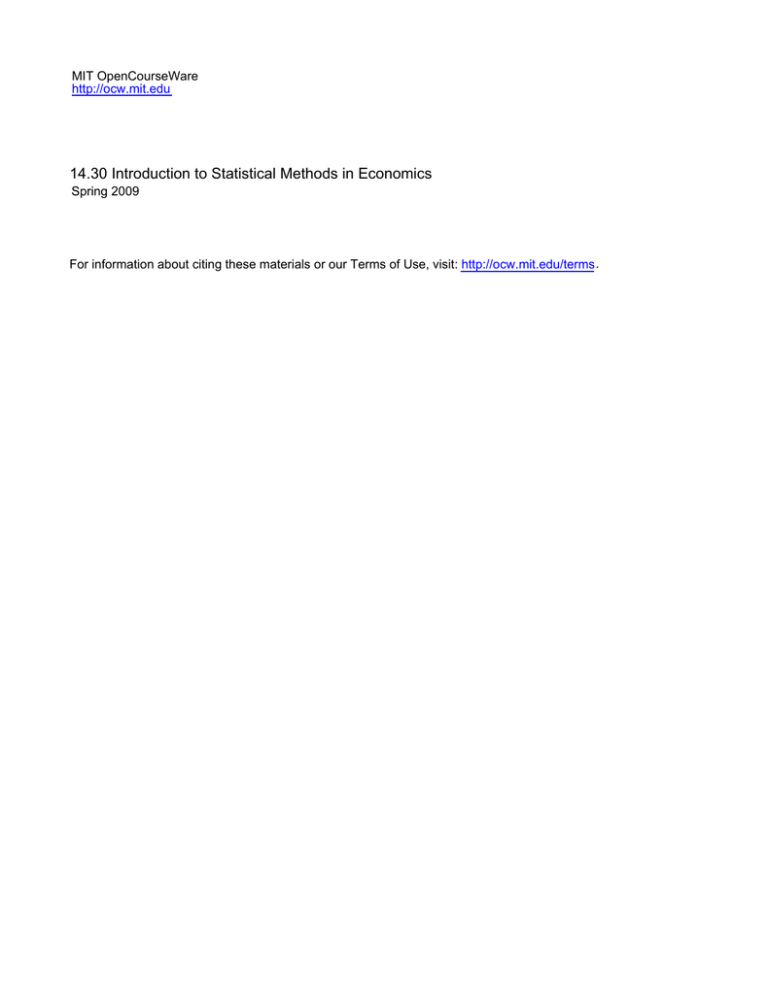
MIT OpenCourseWare http://ocw.mit.edu 14.30 Introduction to Statistical Methods in Economics Spring 2009 For information about citing these materials or our Terms of Use, visit: http://ocw.mit.edu/terms. Problem Set #5 14.30 - Intro. to Statistical Methods in Economics Instructor: Konrad Menzel Due: Tuesday, March 31, 2009 Question One The convolution formula is a useful trick when we are interested in the sum or average of independent random variables. In the last problem set, we dealt with the random variable X, below. e-" forx > 0 f (4= 0 f o r x < O Now, suppose that X = XI = X2 = . . . = Xk are independent, identically distributed random variables. + 1. Using the convolution formula, determine the PDF of fi = ;(x1 X 2 ) Hint: Define Zl = X1 and Z2 = XI X2 and then use the transformation method to get back to Y2 from 2 2 . + 2. Compute its expectation: E[Y2]. + + 3. Using the convolution formula, determine the PDF for & = ;(XI X 2 X3). Hint: Use the hint from part 1 to define Z3 = X1 X2 X3 and perform a convolution with X3 and Z2 to transform the problem into Z2 and Z3. + + 4. Compute its expectation: IE[Y3]. + + + 5. Using the convolution formula, determine the PDF for Yk= :(x1 X2 . Xk) = Z=I Xk. Hint: Try to determine a pattern from part 1 and part 3 using the methods from their hints. :ck 6. Compute its expectation: E[Yk]. 7. What does this tell us about the mean of a sample of size Ic? Is this property specific to the exponential distribution? Explain. Question Two (BainIEngelhardt , p. 228) Suppose that XI,X2,. . . ,Xk are independent random variables and let Y , = ui (Xi) for i = 1 , 2 , . . . , k. Show that Yl, Y2, . . . , Yk are independent. Consider only the case where Xi is continuous and yi = ui(xi) is one-to-one. Hint: If xi = wi(yi) is the inverse transformation, then the Jacobian has the form For extra credit, prove the Hint about the Jacobian. Question Three Moved to a later problem set. Question Four Order statistics are very useful tools for analyzing the properties of samples. 1. Write down the general formula of the pdf and cdf for the kth order statistic of a sample of size n of a random variable X with CDF F'(x). Question Five (BainIEngelhardt p. 229) Let X1 and X2 be a random sample of size n = 2 from a continuous distribution with pdf of the form f (x) = 2x if 0 < x < 1 and zero otherwise. 1. Find the marginal pdfs of the smallest and largest order statistics, Yl and Y2. 2. Compute their expectations, IEIYl] and IE[&]. 3. Find the joint pdf of Yl and Y2. 4. Find the pdf of the sample range R = Y2 - Yl. 5. Compute the expectation of the sample range, IE[R]. Question Six (BainIEngelhardt p. 229) Consider a random sample of size n from a distribution with pdf f (x) = 1 5 x < 00; zero otherwise. 1 x if- 1. Give the joint pdf of the order statistics. 2. Give the pdf of the smallest order statistic, Yl. 3. Compute its expectation, EIYl], or explain why it does not exist. 4. Give the pdf of the largest order statistic, Y,. 5. Compute the expectation, IE[X],of a single draw X from f (x). Does the integral diverge? What does that say about the existence of E[Y,]? Explain. 6. Derive the pdf of the sample range, R = Y, - Yl, for n = 2. Hint: Use partial fractions, searching o n Yahoo for "QuickMathn will help you get the partial fractions via computer: http://72.3.253.76:8080/webMathematica5'/quickmath/page.jsp ?sl =algebra&s2=partialfractions&s3= basic 7. Compute its expectation, E[R], or explain why it does not exist. 8. Give the pdf of the sample median, Y,, assuming that n is odd so that r = (n 1)/2 E N.Express the pdf as a function of just r and y, (eliminate all n's and k7s). + 9. Compute its expectation, E[Y,], or explain why it does not exist.
